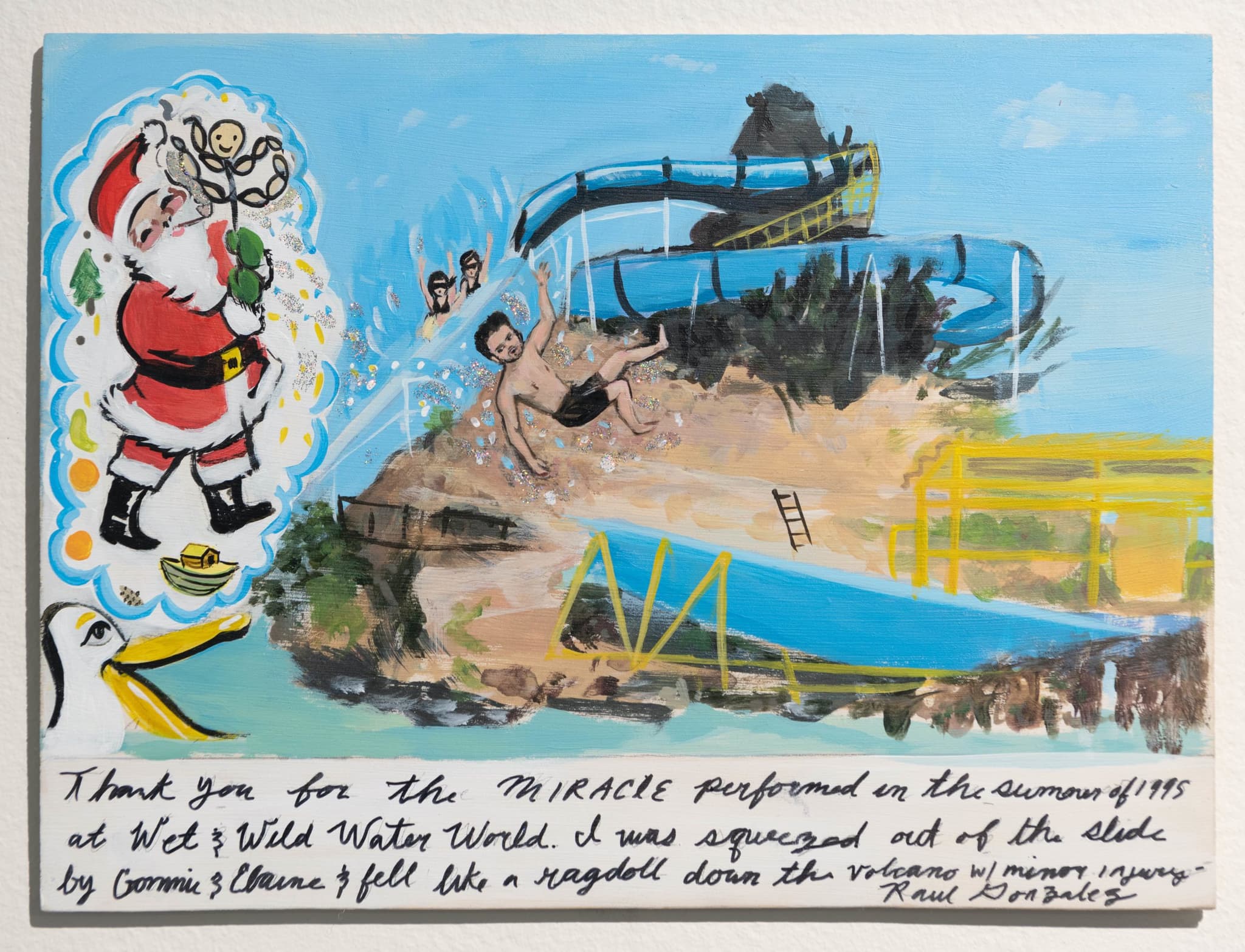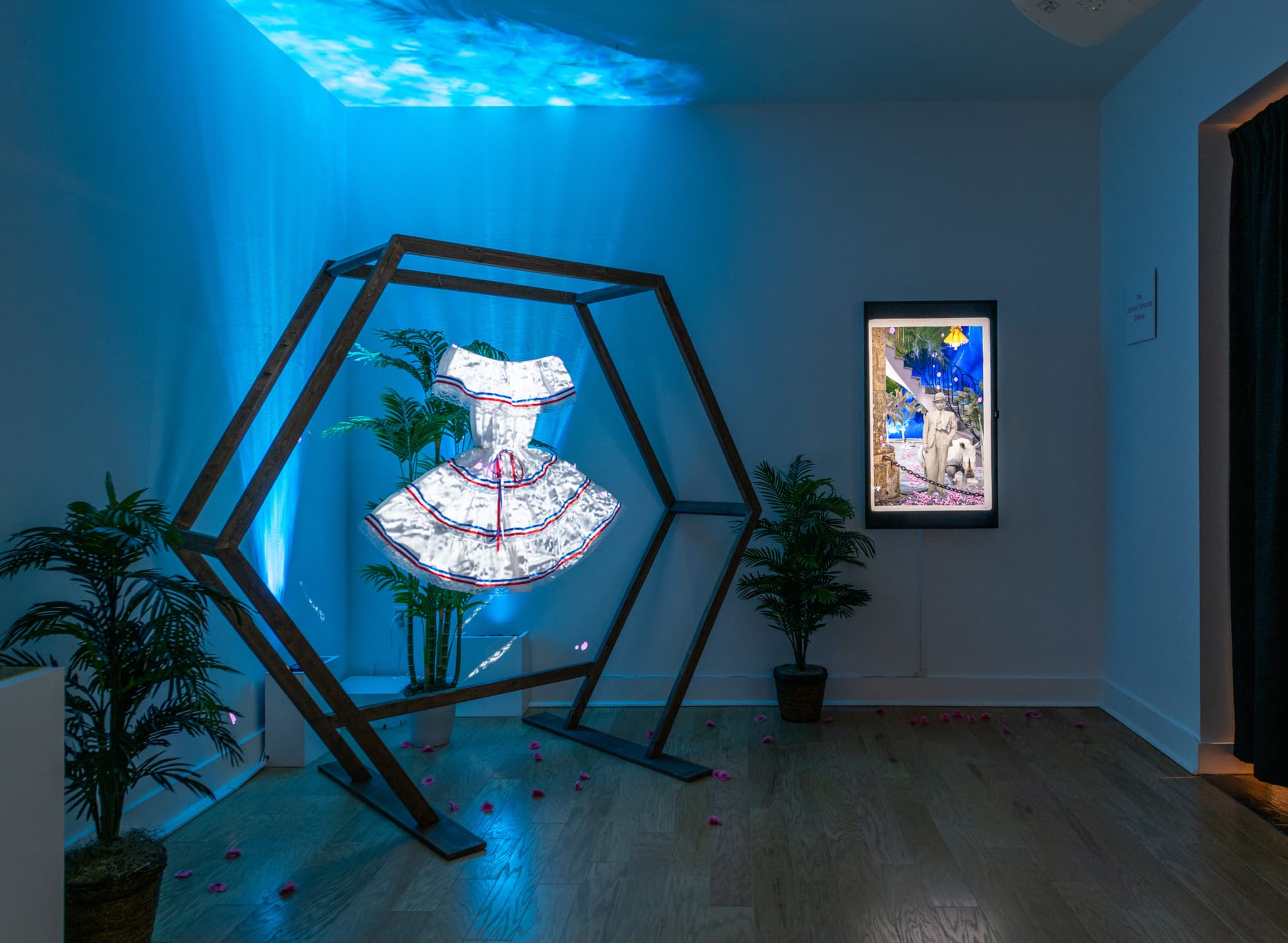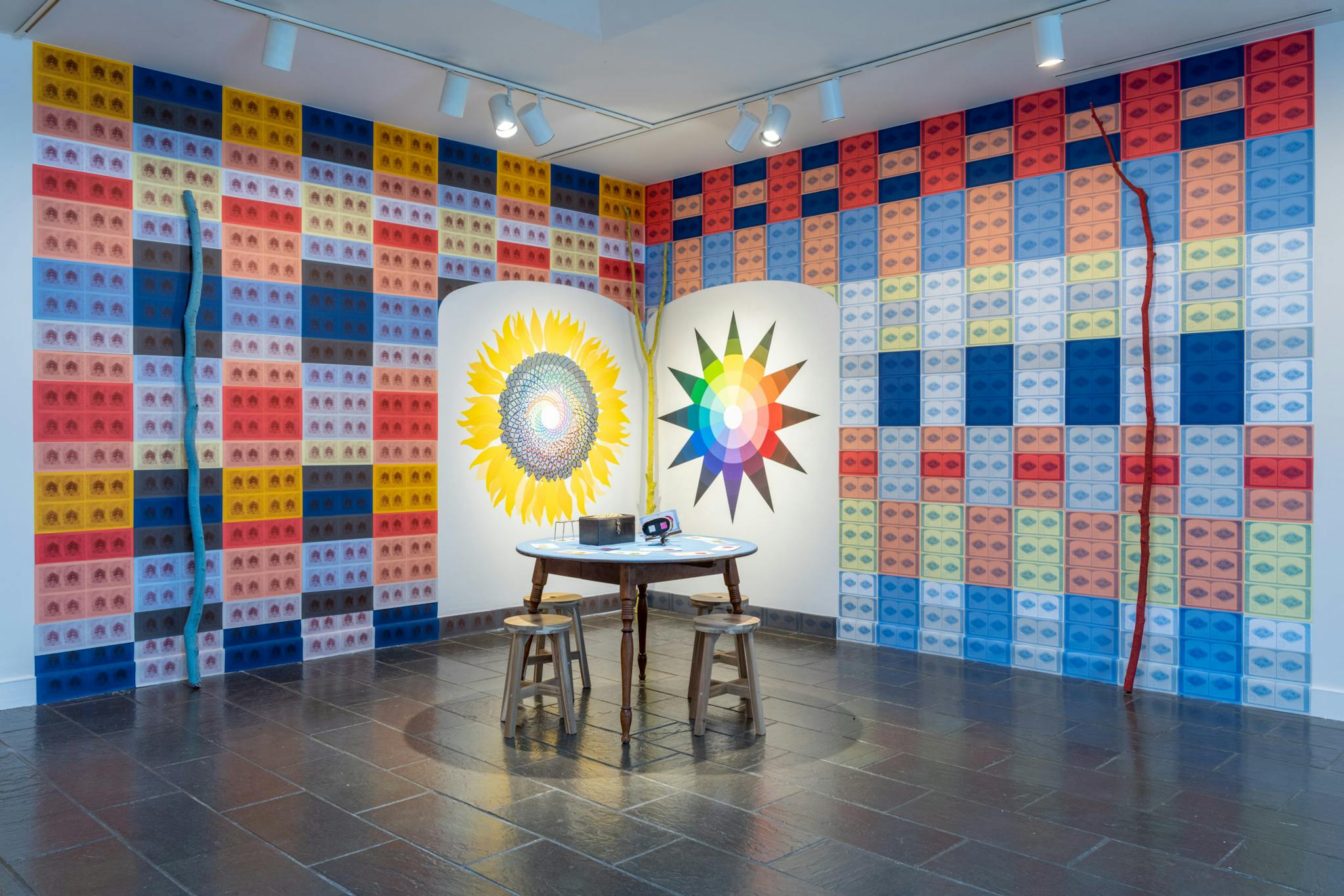A tiny table set on a pedestal is covered in figurines of winking Santas. Above it hangs a cutout calavera, an ornate skull usually associated with the Day of the Dead, this time cleverly composed of Christmas imagery: a black hole around its nasal bone is replaced with a cheerful Christmas tree. To the right, a row of ex-votos—typically Christian votive offerings to saints or other divine figures—narrates true near-death experiences, ranging from almost fatally falling off a Water World ride to nearly setting the house on fire at age five after discovering the pleasures of lighting a match.
This is the view of St. Nicholas Shrine, an installation by Rhonda Ratray that greets the visitors entering After Spiritualism: Loss and Transcendence in Contemporary Art, an exhibition curated by Lisa Crossman at the Fitchburg Art Museum. The shrine is adorned in tinsel and surrounded by electric candles. In Christian tradition, ex-voto paintings are meant to serve as proof of miracle and convey solemnity. Here, the atmosphere of celebration makes it hard to take the narrators’ dances with death completely seriously. They had eluded the fatal end and, retroactively, we as viewers and they as narrators contemplate it with humor. The work exposes how close we are to their terrifying experiences, even if we don’t want to acknowledge it. Just like us, they live in a largely mundane world that transformed the Christian St. Nicholas into the commodified Santa Claus.
After Spiritualism explores the ways contemporary artists conceptualize death, loss, and acts of commemoration, both personal and collective. It also features works by artists who practice Spiritualism and Spiritism (espiritismo, a syncretic variation of Spiritualism common in Latin America) and who draw on themes of the afterlife and the spirit world. It is worth noting that the show does a wonderful job of staying relevant on a local level: all but one of the featured artists are based in New England or New York, and the Learning Lounge, though separate from the show, delves deep into the local history of Spiritualism and its ties to the abolitionist and women’s suffrage movements. The exhibition consolidates the topics of postmortem portraiture, past and present rituals of mourning, and the growing revisionist movement of monuments and memorials by thoughtfully grouping the works into three distinct displays.

Rhonda Ratray, St. Nicholas Shrine (detail), 2007–2020, mixed media installation, dimensions variable. Photo by Charles Sternaimolo
St. Nicholas Shrine opens the “Sacred Spaces” section. Opposite, Maria Molteni’s installation transforms the space into what appears to be a séance arrangement: a round vintage table is set in a corner, surrounded by four wooden stools; the walls are covered in a bright geometric pattern loosely resembling an assortment of tarot cards. On the table atop dispersed cards rests a small chest, while on the walls, images of a sunflower (the emblem of Spiritualism) and a color wheel overlap the pattern. The wordplay of the work’s title, Bough House / Bauhaus, links the iconic German art school to the Bough House, a shed built of flowering free branches in Lily Dale, New York, where the first clairvoyant message service was held. Challenging the prevalent perception of Bauhaus as rational and restrained, Molteni points to the overlooked history of the school’s engagement with the occult as told by Elizabeth Otto in her book Haunted Bauhaus. The installation is interactive and invites the viewer to explore the wonders of a stereoscope, an optic device for viewing three-dimensional images and an artifact of nineteenth-century magic, which also sits on the table. The stereoscope metaphorically unites Bauhaus and Spiritualism, two disparate movements that are almost always viewed through separate lenses. This is indicative of the way Molteni herself understands artistic practice: in an interview with Lacey Prpic Hedtke, she stated that she views art as a “spiritual practice and search for some sort of next level or truth through form.”

Allison Maria Rodriguez, In the Presence of Absence, detail view, 2017–2020. Multi-channel video installation. Photo by Charles Sternaimolo.
A separate, dimmed room lends itself well to the mesmerizing installation by Allison Maria Rodriguez, In the Presence of Absence, displayed as a small devotional space. A traditional Cuban dress, hung in the main corner, appears weightless among potted palm trees; the floor is covered in pink petals and the soft light emanating from nearby flat screens makes them almost appear as stained glass windows. In her projections, sepia photographs of the artist’s ancestors are placed alongside images of extinct species while Cuban monuments are arranged against a bright backdrop resembling meteorology charts tracking hurricanes that have devastated Cuba in recent history. One can read it as a looming threat of climate change that will affect innumerable lives and species, or as an act of resistance against letting these collective and personal memories fade to black.
The “Ritual and Transformation” gallery opens to a display of photography and mixed media works by Julie K. Gray and Rose Marasco. Gray adorns reproductions of found postmortem photographs from the late 1800s and early 1900s with appliqué and sequins, treating human mortality as far from ominous. Viewed from a distance, Postmortem: Margaret looks almost abstract and conceals the faded subject of the photograph with bright patchworks of flowers. Time is an important element of the work: by being presented these caskets that took hours to embroider, the viewer is invited to consider just how disconsolate such sights truly are. Rose Marasco’s Diaries series explores the potential of found objects differently: she photographs pages of old diaries, mounts them in found vintage frames, and adorns them with leaves, fruits, and other objects significant to the diaries’ content. The results are beautiful compositions that resurrect the thoughts and days of anonymous women at the beginning of the twentieth century. There is a lot of empathy for her subjects, and she asks the viewer to consider how, within one century, the pace of our lives has accelerated and left us with little space for lull and tranquility.

Center: Julie K. Gray, Untitled (EVP Recording Altar), 2019. Left wall: Rose Marasco, Diaries, 1994–2000, dimensions variable. Right wall: Julie K. Gray, Postmortem: Aleksandr (left), 2019 and Postmortem: Margaret (right), 2019. Photo by Charles Sternaimolo.
“Historical Hauntings” is the last and perhaps most unsettling gallery to visit, but one that creates the most stirring dialogues. The sounds of John Brown’s Body! fill the space. Conceived by Laylah Ali as a web project, the work invited participants to record themselves while singing versions of the folk song “John Brown’s Body” to the accompaniment of a guitar or as a solo. The original song narrates the story of John Brown, the abolitionist who was hanged in Virginia after an uprising. While his methods are questioned by historians today, Brown became a symbol of liberty during the Civil War, and the melody was combined with lyrics by Julia Ward Howe to create “The Battle Hymn of the Republic.” Played on loop, this simple tune is inescapable and permeates one’s mind long after the visit.
In the center of the gallery, Brian Knep’s Deep Wounds invites the visitor to walk across two white rectangles made of polished tiles. Each step activates two dates, a relationship type, and two places—for example, “1844. Classmate. Tennessee. 8 October, 1862. Perryville.” This data denotes the graduation year and death date, state, and battle of Harvard graduates who chose to fight for the Confederacy and whose names are absent from the university’s Memorial Hall, where the names of Harvard’s Union fighters are honored. By framing these men as brothers, roommates, and friends, Knep points to our common humanity and offers hope that by acknowledging the past fully we could open the path toward reconciliation. To the left of Deep Wounds, three large-format paintings by Keith Morris Washington from their Within Our Gates series intensify the conversation on the power of memorials. Subtitled “Site and Memory in the American Landscape,” the paintings slowly explain the horrifying events that served as a subject for each work. At first glance, they depict merely a field, a forest, a suburban landscape; the compositions are fragmented into several rectangles painted either in black and white or at a different focal length, as if viewed through a prism. However, each is accompanied by a newspaper article telling of a lynching that took place at the site, which has since been built over or abandoned.
Washington amends the year of each lynching, accentuating discomfort—we would like to believe that the events belong to another era, but what if they happened not so long ago? The series gestures toward the absence: by neglecting to mark the events that once took place, we are ignoring the pain of the victims of mob violence, as well as the extremes of racism. This adds to the debate on which stories are obliterated and which live on, and how these choices inform our understanding of history.

Brian Knep, Deep Wounds, 2019, interactive video installation with tile formations. Photo by Charles Sternaimolo.
After Spiritualism was originally conceived as an exploration of loss and how our response to it has evolved. The idea came to Lisa Crossman several years ago in a conversation with Sarah Montross, who curated Visionary New England, a show at the deCordova Museum that explores mystical and utopian practices that informed New England’s culture in the nineteenth century. The two shows, as well as Recruiting for Utopia: Print and the Imagination at the Fruitlands Museum (both pending an updated opening date), were all organized in collaboration with one another, and in sum contend with past and present ideas of utopianism and Spiritualism.
The Learning Lounge adjacent to the exhibition provides the opportunity to learn more about Spiritualism and, more importantly, to be surprised by its rich local history. (It was baffling to learn that one of the first spirit photographers resided in Boston and in 1869 portrayed Mary Todd Lincoln as embraced by the spirit of her husband, Abraham Lincoln, and that the First Spiritualist Temple can still be viewed today at the corner of Newbury and Exeter streets.) The Lounge also offers a glimpse into how rituals of mourning have changed: it displays a wreath made of hair and a postmortem ambrotype of an infant, both common Victorian tokens of loved ones that would be perceived by many as unsettling today, if not outright morbid. When asked whether she thinks we have recently witnessed a revived interest in Spiritualism and mysticism—I’m thinking of the movies “Personal Shopper” by Olivier Assayas and “Planetarium” by Rebecca Zlotowski, both released in 2016, and of last year’s major retrospective of the work of Hilma af Klint at the Guggenheim—Crossman says she thinks there has: “I think that the tension and uncertainty in the world right now are leading to greater consideration of spiritual themes, their histories, and present practices through a variety of forms, including the visual arts.”
After Spiritualism does more than simply enable us to see how artists are exploring the topics of loss and transcendence. By allocating part of the display to visitors’ notes and stories of loss, it validates our experiences and provides the space for discussion and healing. Some of these stories may bring us back to the memory of losing a first pet or remind us of an acute feeling of loss of a loved one; they resonate with our shared fragility and search for transcendence, common across generations, cultures, and religious beliefs.
________________________________________________________________________
After Spiritualism: Loss and Transcendence in Contemporary Art is on view at the Fitchburg Art Museum, 185 Elm Street, Fitchburg, MA 01420, and has been extended to September 6, 2020. Learn more at fitchburgartmuseum.org




